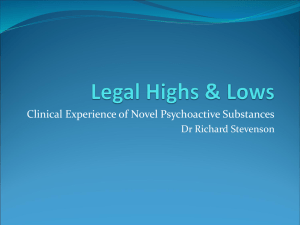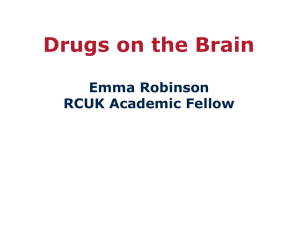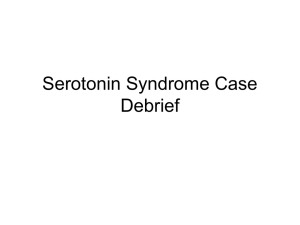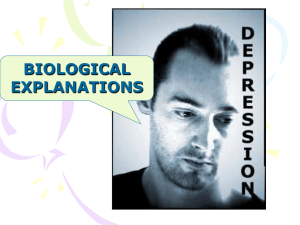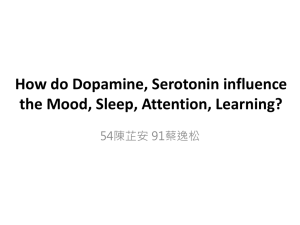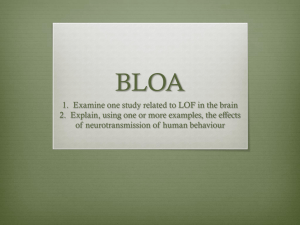Most Common Medication Errors
advertisement
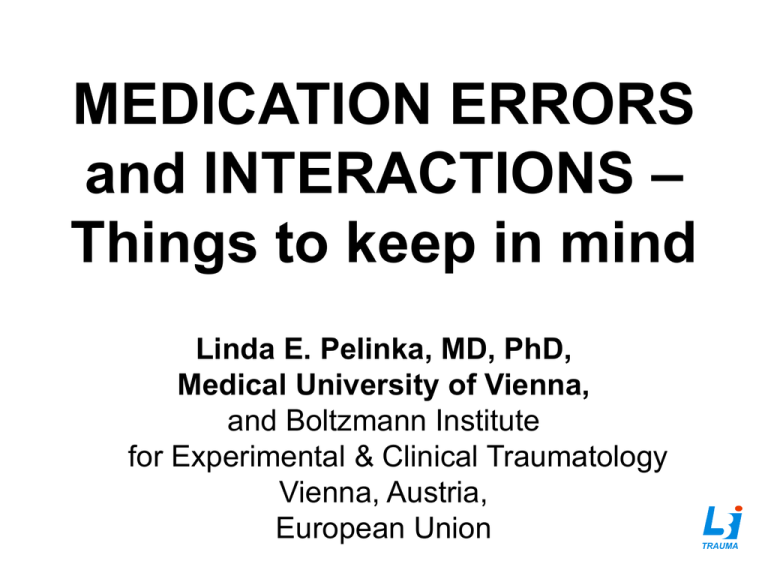
MEDICATION ERRORS and INTERACTIONS – Things to keep in mind Linda E. Pelinka, MD, PhD, Medical University of Vienna, and Boltzmann Institute for Experimental & Clinical Traumatology Vienna, Austria, European Union TRAUMA “Errors in judgement must occur in the practice of an art which consists largely in balancing probabilities.” Sir William Osler British Royal College of Physicians 1883 Physician in chief, Johns Hopkins Hospital 1888 Author of Principles & Practice of Medicine 1 drug error per 133 anesthetics 7 drug errors/AP/year if 1% of errors resulted in injury… Every AP would harm 2 pts in a 30 yr career 1000 APs would harm 2000 pts Glavin RJ. Br J Anaesth 2010; 105/1: 76-82. Anesthesia professionals in the OR are the only med personnel who Prescribe Secure Prepare Administer and Document medications… …a process of up to 41 steps. Martin DE, Penn State College of Medicine. APSF Consensus Conf. 2010 …a process of up to 41 steps. typically without standardized protocols and often in a distracting environment. These steps usually occur within a very short time interval, Martin DE, Penn State College of Medicine. APSF Consensus Conf. 2010 Key System Elements that influence medication use most Poor lighting Cluttered space Noise Interruption Multi-tasking Grissinger M, Ann Meeting American Pharmacists Ass 2007, Atlanta, GA Litigation related to Drug Errors in Anaesthesia: Analysis of Claims against the NHS in England 1995-2007 Cranshaw J et al. Anaesthesia 2009; 64: 1317-23. 93 claims 62 drug administration errors 31 wrong drug 25 wrong dose >50% neuromuscular blockers >30% opioid overdose incl neuraxial route Cranshaw J et al. Anaesthesia 2009; 64: 1317-23. Syringe swaps, Labeling, Routes of administration Male, age 58, Syringe Swap Choosing between only 2 syringes, both known to contain high-risk drugs, the provider ASSUMED instead of reading the syringe label, before injecting the WRONG DRUG by the WRONG ROUTE. Survey of AP 1. Do you ever carry drugs in your pocket? 2. Does every anesthesiologist you know carry drugs in a pocket? 3. Do you think it’s safe to do so? 100% YES to all 3 questions Kulli JC, webmm.ahrq.gov Medication Errors in Anesthetic Practice: Survey of 687 Practitioners Orser BA et al.Can J Anaesth 2001; 42/2:139-46. Most common error: administration of a muscle relaxant instead of a reversal agent. Most common contributing factors: Syringe swaps (70%), label misidentification (47%) Most anesthesiologists (98%) reported reading the ampoule label “most of the time”. Label color was an important secondary cue. In 27 of 28 cases, swaps occur between SAME SIZE SYRINGES Fasting S, Gisvold SE. Can J Anesth 2000; 47/11: 1060-67. Adverse Drug Errors in Anesthesia. Impact of Coloured Syringe Labels. Fasting S and Gisvold SE. Can J Anesth 2000; 47/11: 1060-67. Syringe swaps occurred most often between syringes of equal size. Neither large letters nor colour coding were a strong enough visual cue to prevent errors. Almost no swaps occurred between syringes of different sizes. Using one size of syringe for only one group of drugs might be a strong enough visual cue to reduce syringe swaps. Most frequent Syringe Swaps FENTANYL intended SUCCINYLCHOLINE given NEOSTIGMINE SUCCINYLCHOLINE intended or NM BLOCKER given MIDAZOLAM SUCCINYLCHOLINE intended or NM BLOCKER given Abeysekera A et al. Anaesthesia 2005; 60: 220-27. Litigation related to Drug Errors in Anaesthesia: Analysis of Claims against the NHS in England 1995-2007 Cranshaw J et al. Anaesthesia 2009; 64: 1317-23. Most common adverse outcomes: Awake paralysis Resp depression requiring ICU 15 errors resulted in severe harm or death Drug Administration Errors: a prospective Survey from 3 South African Teaching Hospitals Llewellyn RL et al. Anaesth Intensive Care 2009; 37/1: 93-8. Hospitals A&C treat adults, hospital B peds. Response rates: A+C 48%, B 81% Most common errors, A+C: substitution. B: substitution & incorrect dose. Causes for amp & syringe swaps (substitution errors): 21% syringe misidentification, 37% AMPOULE LOOK-ALIKES. Look-alike Drugs Cause Near Miss Ge Li, MD, PhD, Elgin IL. www.apsf.org/newsletters/html/2009/winter/13_lookalikes.htm To the Editor: I administered anesthesia to a 4 yr old, 15 kg girl for tonsillectomy and adenoidectomy. Because of the size of the tonsils, the surgeon requested 20 mg of dexamethasone iv. Glycopyrrolate was in the same drug tray, close to the dexamethasone vial. Look-alike Drugs Cause Near Miss Ge Li, MD, PhD, Elgin IL. www.apsf.org/newsletters/html/2009/winter/13_lookalikes.htm I was to give 5 dexamethasone vials (4mg/vial). 5 glycopyrrolate vials (0.4mg/vial) would have been at least 10 times more than the max allowable dose. Luckily, I checked the label. I think this “look-alike” is something important and that every anesthesiologist and anesthetist should be aware of the similarity. Amp/Vial Swaps Similar very small writing on amp Same manufacturer Same size Amp/Vial Swaps Amp/Vial Swaps Drug Error in Anaesthetic Practice: Review of 896 Reports from the Australian Incident Monitoring Study Database. Abeysekera A et al. Anaesthesia 2005; 60: 220-27. Wrong route: The most significant factor of this section was the large number of errors associated with regional anesthesia, despite using the normal checks, including aspiration to check for blood. Local Anesthetics: Baricity, Concentration, Additives Compatible Cross Connection The problem of cross-connection of anesthesia gasses recognized >50 years ago. Has been almost eliminated by mandated use of incompatible connectors for different gasses. Preventing catheter/tubing misconnections: Much needed help is on the way. ISMP Medication Safety Alert! Acute Care Edition. July 15, 2010; 15: 1-2. Luer Connector System Shared by different tubing devices used in patient care, including Periperal catheters Epidural catheters IV syringes Kulli JC, webmm.ahrq.gov Prescribing Errors Most Common Prescribing Errors 1 Lack of Lack of DRUG PATIENT knowledge knowledge wrong dose other meds wrong frequency drug interaction allergy Key System Elements that influence medication use the most Pt info: age, weight, diagnoses, allergies Communication Grissinger M, Ann Meeting American Pharmacists Ass 2007, Atlanta, GA Body Weight Over- & Underestimation, common cause of medication errors Unfractionated heparin & LMWH Glycoprotein IIb/IIIa receptor antagonists Fibrinolytic agents (alteplase, tenecteplase) Inotopes (dobutamine) Vasopressors (dopamine, norepinephrine) Vasodilators (nesiritide, nitroprusside) Inodilator milrinone Cockroft DW and Gault MH. Prediction of Creatinine Clearance from Serum Creatinine. Nephron 1976; 16: 31-41. Drugs most commonly misused by health care professionals 1)Insulin 2)Anticoagulants 3)Antibiotics 4) Hydrocodone 5) Ibuprofen 6) Acetaminophen 7) Aspirin Grissinger M, Ann Meeting American Pharmacists Ass 2007, Atlanta, GA Creatinine Clearance Correct estimation is one of the most important factors in dosing Enoxaparin Eptifibatide Tirofiban Bivalirudin Dofetilide Sotalol Cockroft DW and Gault MH. Prediction of Creatinine Clearance from Serum Creatinine. Nephron 1976; 16: 31-41. Top 5 of 355 drugs most commonly associated with errors Analgesics Bronchodilators Antibacterials Anti-anginals Glavin RJ. Br J Anaesth 2010; 105/1: 76-82. Claims involving Allergic Reactions n=31 65% Previously KNOWN allergen >30% Penicillin 35% 20% severe reaction Previously UNKNOWN No lasting sequelae allergen 45% death 40% cardioresp arrest CNS damage Cranshaw J et al. Anaesthesia 2009; 64: 1317-23. Drug administration errors despite allergy or contra-indication Overdose: entire amp given at once Blood to wrong pt % drug forgotton given too fast drug expired syringe already used Abeysekera A et al. Anaesthesia 2005; 60: 220-7. Most Common Prescribing Errors 2 MisCALCULATING Dose Calculation Error Decimal Point Misplacement Drugs most commonly misprepared by health care professionals NM BLOCKER prepared instead of neostigmin VECURONIUM dilution error: H20 w/o vec Morphine dilution error Abeysekera A et al. Anaesthesia 2005; 60: 220-27. Litigation related to Drug Errors in Anaesthesia: Analysis of Claims against the NHS in England 1995-2007 Cranshaw J et al. Anaesthesia 2009; 64: 1317-23. Most common adverse outcomes: Awake paralysis Respiratory depression requiring ICU 15 errors resulted in severe harm or death Although iatrogenic opioid overdosing is a recurrent error reported to the NRLS*, it seems rarely reported in the context of anesthetic care. *National Patient Safety Agency National Reporting & Learning Service Cranshaw J et al. Anaesthesia 2009; 64: 1317-23. Most Common Prescribing Errors 3 MisUNDERSTANDING Misreading, use of Abbreviations Letters & Numerals commonly confused o c g m y 0 e q n z E Z O D S F 2 0 0 8 Z T 5 5 7 7 I 8 3 1 Lavin LA, Prescribing Errors St Louis University APNursing Conference, 2012 Cursive Letters & Numerals commonly confused 1 7 i e a o f 7 g 9 B 8 Confused Drug Names 1 Drug name Zyrtec* Trental* dimenhydrinate dobutamine chlorpromazine Beano* desipramine Confused with Zyprexa* Tegretol* diphenhydramine dopamine chlorpropamide B&O* belladonna&opium disopyramide www.ismp.org, Institute for Safe Medication Practices Dimenhydrinate and Diphenhydramine Dimenhydrinate = DRAMAMINE Diphenhydramine = BENADRYL Both vials same color Both have long names beginning with D Both often stored beside each other in kit Dimenhydrinate is an anti-emetic Diphenhydramine is an anti-histaminic http://medicscribe.com/2010/05/medication-errors-epinephrine Confused Drug Names 2 Drug name sufentanyl tramadol ephedrine Ketalar* hydrocodone hydromorphone Norcuron* Confused with fentanyl trazodone epinephrine ketorolac oxycodone morphine Narcan* www.ismp.org, Inst. f. Safe Medication Practices * brand name Confused Drug Names 3 Drug name clonidine lorazepam Humalog* Nexium* nifedipine iodine Lamisil* Confused with clozapine, clonazepam Lovaza* Humulin* Nexavar* Nimodipine, nicardipine Lodine* Lamictal* * brand name www.ismp.org, Institute for Safe Medication Practices Confused Drug Names 4 Drug name Dioval* Dilaudid-5* disopyramide Evista* Neo-Synephrine (oymetazoline) methadone Confused with Diovan* Dilaudid* desipramine Avinza* Neo-Synephrine (phenylephrine) Metadate*, Mephyton* www.ismp.org, Institute for Safe Medication Practices Drug Interaction SEROTONIN = 5-HYDROXY-TRYPTAMINE L Tryptophan DECREASE METABOLISM MAO Inhibitors: Isocarboxazid Selegiline (Antiparkinson) Phenelzine Tranylcypromine Moclobemide Antibiotic Linezolid Methylene blue Modified according to Rastogi R et al, Anesthesiology 2011; 115: 1293 L Tryptophan INCREASE RELEASE Amphetamines Cocaine Ecstasy Opioids Fenfluramine Sibutramine Phenantherene Modified according to Rastogi R et al, Anesthesiology 2011; 115: 1293 L Tryptophan INCREASED SEROTONIN RECEPTOR SENSITIVITY Lithium Modified according to Rastogi R et al, Anesthesiology 2011; 115: 1293 L Tryptophan SEROTONIN RECEPTOR AGONISTS LSD Lysergic acid diethylamide DHE Di-hydro ergotamine Buspirone Triptans Mirtazapine Modified according to Rastogi R et al, Anesthesiology 2011; 115: 1293 L Tryptophan RE-UPTAKE INHIBITORS SSRI Select. Serotonin Reuptake Inhibitors SNRI Serotonin Noradrenalin Re-uptake Inhibitors 5 HT3 Antagonists Antidepressants Opioids Herbs Mod. according to Rastogi R et al, Anesthesiology 2011; 115: 1293 Serotonin Re-Uptake Inhibitors SSRI Escitolopram Citalopram Paroxetine Fluoxetine Sertraline SNRI Duloxitine Venlafaxine Milnacipran Herbs Ginseng St John’s Wort ANTIDEPRESSANTS Amitryptiline, Imipramine, Clomipramine, Desipramine, Trazodone, Nefazodone OPIOIDS Fentanyl Methadone Meperidine Dextromethorphan Tramadol 5 HT3 ANTAGONISTS Ondansetron Granisetron SSRI Selective Serotonin Re-uptake Inhibitors SNRI Serotonin Noradrenalin Re-Uptake Inhibitors OPIOIDS HAVE A DUAL EFFECT Increased Inhibited Serotonin Serotonin release Re-uptake Differential Diagnosis 1 Condition Serotonin Syndrome Pupils Skin Mydriasis Diaphoresis Bowel sounds hyperactive Anticholinerg Mydriasis “toxidrome” Erythema hot, decreased or dry absent Neurolept malignant Normal Diaphoresis, pallor Malignant hypertherm Normal Diaphoresis , decreased mottled decreased or normal Boyer EW, Shannon M. NEJM 2005; 352/11: 1112-20. Differential Diagnosis 2 Time to Vital signs develop Serotonin <12h Hypertens., Syndrome Tachycardia, Tachypnia, >41.1C Anticholinerg Anticholin <12h Hypertens., Tachycardia, “toxidrome” ergic Tachypnia, <38.9C Condition Neurolept malignant Malignant hypertherm Drugs taken Prosero tonergic Dopamine 1-3 days antagonis t Sux, Inhal 30min anesthetic -24h Hypertens., Tachcardia, Tachypnia, >41.1C Hypertens., Tachcardia, Tachypnia, up to 46C Boyer Shannon M. NEJM 2005; 352/11: 1112-20. Differential Diagnosis 3 Condition Musc tone Reflexes Serotonin Syndrome Increased, more lower extremity Anticholinerg normal “toxidrome” Mental Status Hyper, clonus (unless masked) normal Agitation, coma Brady reflexia Stupor, alert mutism, coma Neurolept malignant “lead pipe” rigidity Malignant hypertherm Rigor mortis- Hypo like rigidity reflexia Agitated delirium Agitation Boyer EW, Shannon M. NEJM 2005; 352/11: 1112-20. The Serotonin Syndrome Boyer EW, Shannon M. NEJM 2005; 352/11: 1112-20. 1) The serotonin syndrome is a predictable consequence of excess serotonergic agonism of CNS & peripheral serotonergic receptors. 2) Excess serotonin may produce a wide spectrum of clinical findings. 3) Clinical manifestations range from barely perceptible to lethal. Altered Mental State Clonus Hyperthermia Restlessness (sustained) Life Threatening Toxicity Mild Symptoms Tremor Clonus (inducible) Muscular Hypertonicity MILD ADVERSE REACTION Anxiety Akathisia Tremor Tachycardia Sweating Diarrhea Mydriasis Discontinue offending drug(s) FULL BLOWN SEROTONIN SYNDROME Clonus Hyperreflexia Hyperthermia Hypertension Add. monitoring, hydration, cooling oxygenation SEVERE SEROTONIN TOXICITY Rigidity >40C Seizure Coma SEVERE SEROTONIN TOXICITY Rigidity >40C Seizure Coma 5 HT Antagonists CYPROHEPTADINE po CHLORPROMAZINE iv Benzos Anticonvulsants ßBlocker Propranolol ICU Intubate & Ventilate Muscle Relaxants Dialysis The Libby Zion Case Asch DA, Parker RM. NEJM 1988; 318/12: 771-5. 18 yr old patient undergoing psychiatric therapy for stress: phenelzine, Percodan (aspirin-oxycodone hydrochloride). Fever and otalgia: Erythromycin, chlorphenamine History: cocaine, marihuana, imipramine, flurazepam, diazepam. After admission: Acetaminophen, haloperidol, meperidine. TAKE HOME MESSAGES Anesthesia errors happen to almost every AP sooner or later. The frequency of drug errors in anesthesia is probably much higher than reported (definition of error). Kulli JC, webmm.ahrq.gov In 27 of 28 cases, swaps occur between SAME SIZE SYRINGES Fasting S, Gisvold SE. Can J Anesth 2000; 47/11: 1060-67. Most frequent Syringe Swaps FENTANYL intended SUCCINYLCHOLINE given NEOSTIGMINE SUCCINYLCHOLINE intended or NM BLOCKER given MIDAZOLAM SUCCINYLCHOLINE intended or NM BLOCKER given Abeysekera A et al. Anaesthesia 2005; 60: 220-27. Drugs most commonly misused by health care professionals 1)Insulin 2)Anticoagulants 3)Antibiotics 4) Hydrocodone 5) Ibuprofen 6) Acetaminophen 7) Aspirin Grissinger M, Ann Meeting American Pharmacists Ass 2007, Atlanta, GA Drugs most commonly misprepared by health care professionals NM BLOCKER prepared instead of neostigmin VECURONIUM dilution error: H20 w/o vec Morphine dilution error Abeysekera A et al. Anaesthesia 2005; 60: 220-27. Serotonin Re-Uptake Inhibitors SSRI Escitolopram Citalopram Paroxetine Fluoxetine Sertraline SNRI Duloxitine Venlafaxine Milnacipran Herbs Ginseng St John’s Wort ANTIDEPRESSANTS Amitryptiline, Imipramine, Clomipramine, Desipramine, Trazodone, Nefazodone OPIOIDS Fentanyl Methadone Meperidine Dextromethorphan Tramadol 5 HT3 ANTAGONISTS Ondansetron Granisetron SSRI Selective Serotonin Re-uptake Inhibitors SNRI Serotonin Noradrenalin Re-Uptake Inhibitors

